Growing Weed Indoors For Beginners - Full Guide For A Successful Indoor Grow
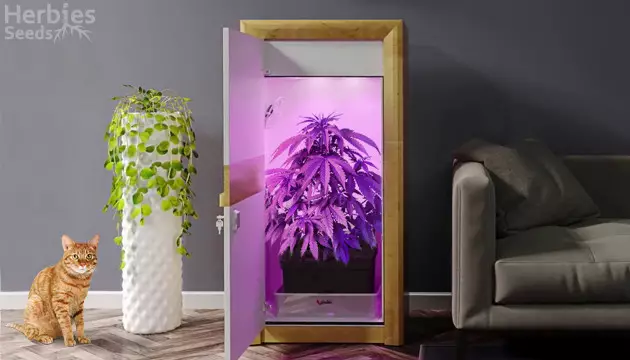
While it does take some effort, growing weed is relatively easy. If you’re interested in growing cannabis but don’t have the option of growing outdoors, an indoor weed grow setup is something to seriously consider. With just a little know-how, you can soon be growing weed indoors and harvest a stash you can be proud of. In the following article, you’ll find everything you need to know about growing weed indoors step by step so you can get started on becoming an indoor cannabis grower.
Essential Equipment For Growing Cannabis Indoors
First things first – if you’re interested in growing weed indoors, you’re going to need the equipment that allows you to do so. So, what exactly do you need for an indoor grow setup?
- For starters, you’ll need a good grow light. Your grow light is what replaces the natural sunlight that plants need to grow and thrive. Without a light, growing weed indoors is virtually impossible.
- Pots, soil or the growing medium of your choice are also essential, as well as the nutrients that will help your plant(s) thrive.
- A fan will help air circulate in your indoor grow, which ultimately improves photosynthesis, nutrient uptake, and overall plant strength and development.
- If you don’t have a closet or entire room that you can dedicate to growing weed indoors, a grow tent is another great option for growing indoor cannabis.
Choosing The Ideal Indoor Grow Area
Choosing the best area in your house for your indoor grow is a crucial part of the process. Basically, this can be anywhere dry and cool that can be sealed from outside light. Here are the most common cultivation areas indoor cannabis growers choose:
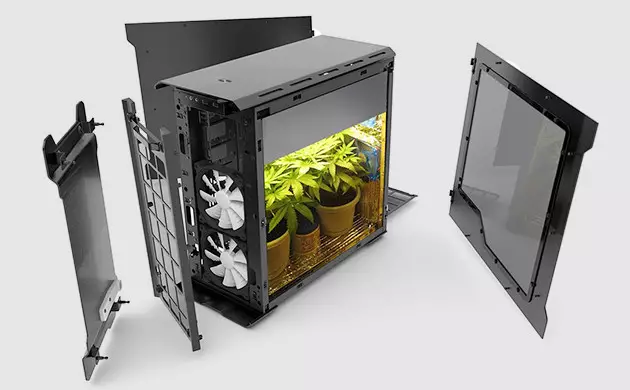
- Stealth Weed Grow Space
If you don’t have a lot of room or need to be secretive about your indoor grow for whatever reason, growing in a stealthy spot like a closet or cabinet will work perfectly. Many beginner indoor growers start with a spare closet, which can be easily managed and isn’t too expensive to set up. Some super stealth options even include microgrowing weed in a used PC box!

- Cannabis Grow Tent
Grow tents are another popular option when it comes to growing cannabis indoors. These are made especially for indoor setups, keeping both light and cannabis smell trapped inside. Cannabis grow tents also have reflective material on the inside, allowing light to reach all areas of all your plants. Grow tents also come equipped with openings for electric cables, as well as vent openings at both the bottom and the top which allow air to circulate freely.
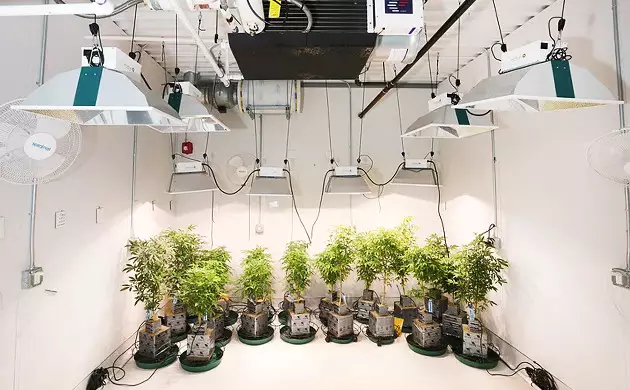
- Grow Room
If you want to go big right off the bat, you could consider dedicating an entire room to your indoor grow. Spare bedrooms and basements are popular areas for growing weed indoors. Keep in mind that if you choose to set up in an entire grow room, it’s going to be the most expensive option and will require the most maintenance.
Note: The bigger the pot size, the bigger your marijuana plant will be. Overall yields will vary depending on pot size, genetics, care of your plants, size of your grow space and lighting.
Choosing The Best Strain To Grow Indoors
One of the most exciting things about growing cannabis indoors is choosing your weed strains. When choosing what cannabis strain to grow indoors, you’ll need to keep a couple of things in mind.
Space is one of the biggest factors when deciding on what strain to grow indoors. While you might have your heart set on a Sativa-dominant strain, they tend to grow really tall and aren’t necessarily the best option for indoor grows. Growing Indica or hybrid strains is typically preferred for growing weed indoors, unless you’ve got extremely high ceilings for Sativas or are ready to implement low and high-stress training techniques to keep the size manageable.
When picking a strain for your indoor grow, choosing cannabis seeds especially suited for indoor growing is your best option. Some of the most popular strains to grow indoors include:
- GG#4 Original Glue: Combines manageable heights of 100-150cm (3-5ft) indoors, with impressive yields of up to 800g/m2 (2,6oz/ft2).
- Girl Scout Cookies: This modern classic reaches medium-sized heights, with indoor yields of up to 250g/m2 (0,8oz/ft2) or more – a perfect recipe for a truly satisfactory indoor harvest.
- Gelato Auto: Only reaches heights of 70-100cm (2-3ft) and is very easy to grow – perfect for stealthy setups.
Autoflowering cannabis strains are also awesome for growing indoors because they grow quickly and don’t tend to get as big as photoperiod plants. Using an autoflowering strain lets you leave lights under a preferred fixed light schedule from seed through harvest, which is great for growing weed indoors for beginners.
What Are The Best Lights For Your Indoor Grow?
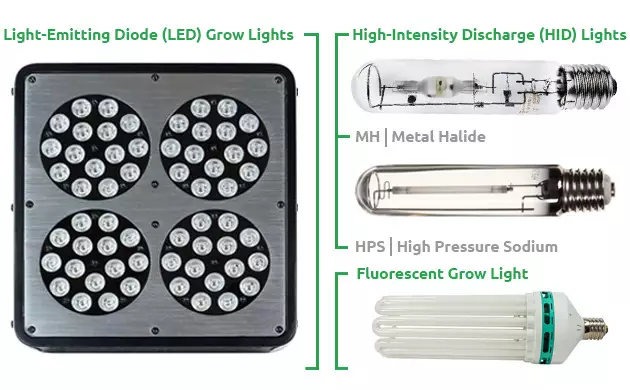
Lights are the foundation of any indoor grow setup. The better the light you use, the better your indoor cannabis grow will be – including your overall yields come harvest time. Here are a few types of lights to consider when growing weed indoors:
- Fluorescent Lights
Fluorescent lights have been used by indoor cannabis growers for years. They’re inexpensive, don’t use a lot of electricity, cover a large amount of space and are cooler than other grow lights. A disadvantage of fluorescent grow lights is that they typically result in smaller yields per watt than other types of lights. They’re also not the best for flowering or vegetative stages of plant growth.
- HID Grow Lights
HIDs are extremely popular with indoor growers because they’re the most efficient for growing weed indoors, offering the highest yield per watt. There are three types of HID lights: metal halides (MH), high-pressure sodium (HPS) and a cross of both. HID light systems include a light, ballast and reflective cover that ultimately increases the supply of light your indoor plants receive. On the downside, HID lights produce a lot of heat, are more expensive and require the ballast.
- LED Grow Lights
LED grow lights are one of the newest types of grow lights that can offer amazing results. They produce more light per watt than other types of grow lights but are energy-efficient, and come with the lowest power cost of all types of grow lights. LED lights offer a range of light spectrums that can typically be adjusted during different stages of plant growth. While sometimes they’re more expensive than other types of grow lights, they’re easy to use and a better long-term investment.
Choosing The Best Medium For Growing Weed Indoors
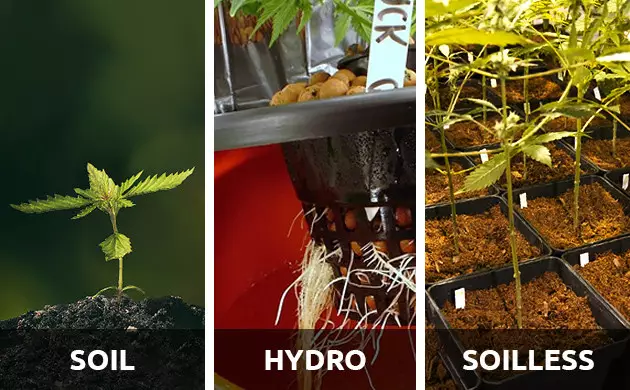
The next thing to consider when growing weed indoors is the type of growing medium you’ll use: soil, soilless or a hydroponic setup. Let’s go through each of them to help you decide on a perfect growing medium for your indoor grow.
- Soil
Soil is the easiest option, especially when it comes to growing weed indoors for beginners. You’ll find a wide selection of potting soil at grow stores. Just make sure it doesn’t contain any synthetic time-released nutrients – they may eventually result in a nutrient lockout. There’s also the option of organic supersoil with nutrients already added, which can eliminate the need for adding nutrients almost entirely.
- Hydro And Soilless
You can also choose to go with a hydroponic setup, although growing hydroponically is more technical and typically not included into any guides dedicated to growing cannabis indoors for beginners. A soilless medium like coco coir is also an option. Keep in mind that hydro and soilless mediums will require nutrients and extra attention throughout the entire lifecycle of plant growth.
What Are The Best Pots For Growing Indoor Weed?

Assuming you go the soil route, you’ll need to choose the best pots for growing weed indoors. You’ll need at least two different sizes, including small pots for seedlings or clones and larger pots when your plants begin to grow. 20-liter (5-gallon) pots are ideal for indoor setups, unless you’ve got the space for larger pots (bigger plants) and enough light to ensure all plants are getting the light they need.
Fabric pots (like Smart Pots or similar) work best, as they allow roots to breathe better, improve root structure, regulate temperature, and prevent overwatering with their excellent drainage. After your grow, fabric pots can be washed, folded and easily stored for your next indoor grow. While fabric pots are ideal, you can also do no wrong by using classic plastic or terracotta pots.
The Best Nutrients For Your Indoor Grow
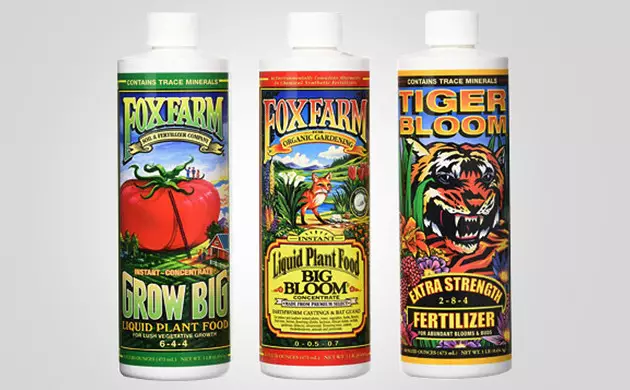
Unless you’re using potting soil with nutrients added to it, you’ll need to give your plants fertilizer throughout their entire lifecycle. The best bet for beginner growers is to purchase a nutrient “pack” that contains the various nutrients your plants will need during the different growth stages. FoxFarm Trio, for example, contains three bottles of nutrients designed for the vegetative, flowering and blooming stages of cannabis growth respectively.
Essential macronutrients for cannabis include nitrogen, phosphorous and potassium. NPK ratios are typically labeled on nutrient packaging in a numerical sequence. Essential micronutrients for cannabis include calcium, magnesium, copper and iron.
Aside from the micro and macronutrients cannabis plants need, you’ll also need to make sure you control the pH level of your soil and water when growing weed indoors. If growing in soil, ideal pH levels for weed plants is 6.0-7.0. Hydroponic setups and soilless mediums require a pH of 5.5-6.5.
How Much Water Do Indoor Cannabis Plants Need?
While it’s a given that cannabis plants need water, knowing how much water to give them isn’t as straightforward as you may think. Over and underwatering can be common with beginner growers, but marijuana plants need a balance of wet and dry soil for roots to grow and thrive. Often, you can tell if your plant needs water simply by looking at it. A plant that appears weak, with leaves that have begun to wilt and turn yellow or brown, needs water. An overwatered plant will look similar, but leaves will be dark green and curled slightly inward.
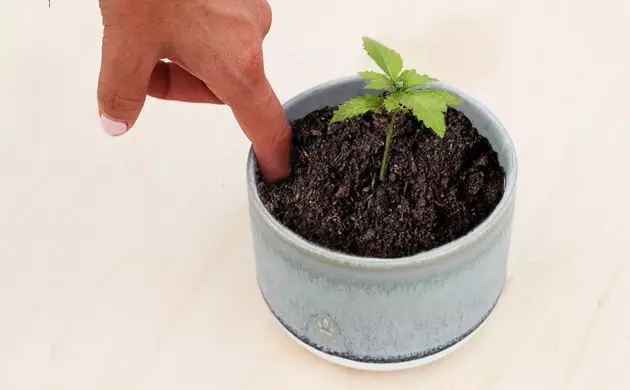
One of the easiest ways to determine if your plants need to be watered is to stick a finger about 5cm (2 inches) into the plant’s soil. If it’s dry, it’s time to water your plant. You can also pick up the pot your plant is in. If it’s light, your plant likely needs to be watered. Be sure to pick up your plant after it's been watered to determine how heavy it is when it doesn’t need water. It’s best to underwater your plants than overwater them, as the former issue can be resolved more easily, but you still don’t want them to get too dry.
Pot size and stage of growth will determine how much water your plants need. Getting plants on a regular watering schedule is recommended, with most growers setting a schedule to water every 2-4 days.
Identifying Male And Hermaphrodite Marijuana Plants
Female plants offer the big, dense buds that are the end goal of any cannabis grower. While buying feminized seeds is ideal, not everyone starts out with seeds that promise to produce buds. If you’re learning how to grow your own weed, it’s essential to be able to identify male and hermaphrodite plants. These will need to be removed from your indoor grow as, if not, they’ll pollinate the female plants. If the pollination happens, female plants will produce seeds instead of potent, psychoactive buds.
In order to remove any male plants from your indoor grow, the sex of marijuana plants should be determined shortly after the light schedule is switched to 12/12, or when plants enter the beginning stages of the flowering period.

Male plants can be easily recognized by the formation of small pollen sacs that develop on the nodes of the plant. They resemble small balls, as compared to the small white hairs (stigmas) that will form on the nodes of female plants.
Hermaphrodite plants develop both male and female sex organs, which typically occurs when plants experience a lot of stress. If you notice your plant has both pollen sacs and stigmas, simply remove the male pollen sacs from the plant nodes. When taken care of properly, hermaphrodite plants can still produce a sizeable harvest.
Protecting Your Indoor Grow From Predators
Growing weed indoors doesn’t mean your plants are automatically protected from pests and other potential influences that can make a good grow go bad. You’ll want to check on your cannabis constantly throughout its growth to ensure that pests and predators (including your lovely pets) haven’t invaded your plants.
Spider mites are common with indoor grows, which can be easily taken care of with a non-toxic pesticide. Neem oil mixed with water is excellent for getting rid of pests, offering an all-natural solution to keeping your plants free from indoor predators.
Indoor plants can also develop mold, with powdery mildew being the most common to invade cannabis plants. It can be easily recognized as a thin layer of white powdery mold on the leaves of your plant. Prevention is the best way around this common problem. Make sure your plants are getting enough airflow.
Growing indoors in humid environments will require a fan to be on at all times. Make sure your grow room temperature is above 20 degrees Celsius (68F), as mold thrives in cooler temperatures. With good ventilation and proper temperature control, avoiding powdery mildew is completely possible.
When And How To Harvest Your Indoor Grow
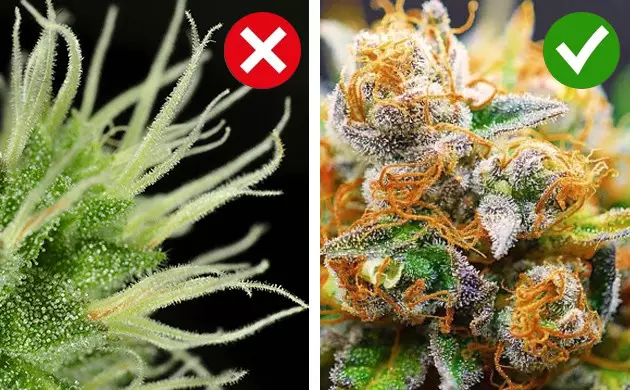
There’s nothing quite as satisfying as harvesting your own marijuana plants. All your hard work has finally paid off and its time to reap the fruits of your labor.
There’s window for harvesting marijuana plants, and you’ll find they’re ready to go when bud growth stops and about 40-50% of the white hairs (pistils) become an orange or brown color. Also look for the change in the color of trichomes, tiny bulbs of resin that you can see with a magnifying glass or your phone’s camera zoomed in. First, they’ll turn milky-white, then the trichomes will start becoming amber. At this point, you can already start harvesting your indoor cannabis grow.
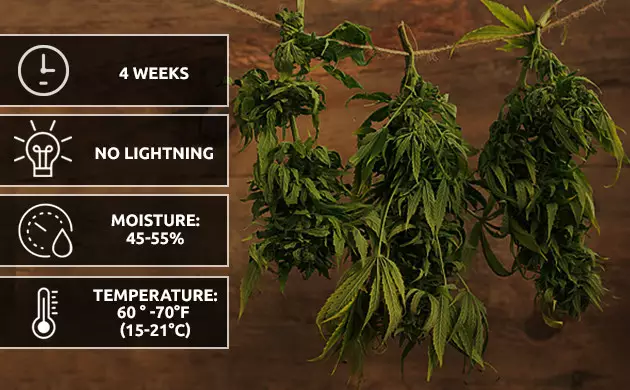
From this time forward, you have a couple of weeks to cut down your plants. Once cut, plants should be kept in a dark room with temperatures between 15-21 degrees Celsius (60-70F), with a small fan going and humidity levels between 45-55%.
Final Thoughts On Growing Weed Indoors
If you want to learn how to grow good weed at home, growing indoors is one of the best solutions. Growing cannabis indoors step by step with the proper lights, ventilation, growing medium and TLC will ensure an indoor harvest any grower can be proud of. It also offers the opportunity to grow weed all year round, offering the desirable option of never having to buy weed from anyone again.
Herbies Head Shop expressly refuses to support the use, production, or supply of illegal substances. For more details read our Legal Disclaimer.




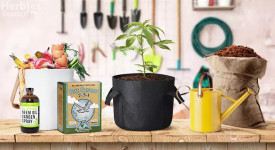

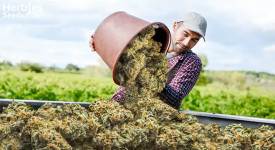


Thank you for leaving a comment for us!
Your feedback will be posted shortly after our moderator checks it.
Please note that we don’t publish reviews that: